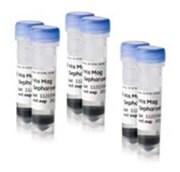Manual and Automated Purification
Recombinant proteins are needed for research and industrial purposes in different qualities (e.g., with native structure or denatured) and quantities (from microgram to gram scales). One needs to choose a purification method that will yield protein of a quality and quantity that fits the intended use. The number of samples that must be purified is also an important consideration. It may be possible to save valuable time and protein samples by investing in a chromatography system.
Tagged recombinant proteins for simple purification
When a recombinant protein is fused to a peptide or protein tag, such as histidine, glutathione S-transferase (GST), maltose binding protein (MBP), or Strep-tag II, the properties of the tag can be exploited for purification purposes. AC methods have been developed for each of the commonly used tags, and there is a good chance of a successful purification of a tagged protein in a single step.
Manual purification techniques
A number of manual purification formats are available for purification of tagged proteins (Figure 2.1 to 2.5). All formats are based on established chromatography media and include gravity-flow columns (GraviTrap™), spin columns (SpinTrap™), magnetic beads (Mag Sepharose®), and 96-well plates (MultiTrap™). In addition, prepacked HiTrap® columns can be used with a syringe for manual purification. The different formats are suitable for single samples as well as multiple samples in parallel. Magnetic beads and 96-well plates can also be used in combination with a robotic device, for example, during screening and process optimization.

Figure 2.1. Mag Sepharose® paramagnetic beads.
Mag Sepharose® paramagnetic beads are designed for simple enrichment of proteins and small-scale purification or screening. The slurry volume of Mag Sepharose® beads can be varied in a linear manner to match capacity needs, and large sample volumes of low-expressed target protein can be enriched and concentrated. Sample volume from a few microliters to about 50 mL can be used with Mag Sepharose® in combination with the magnetic racks MagRack 6 and MagRack Maxi. Mag Sepharose® products for histidine-tagged proteins: His Mag Sepharose® Ni, His Mag Sepharose® excel.

Figure 2.2.SpinTrap™ microspin columns.
SpinTrap™ prepacked microspin columns enable fast small-scale purification of target protein using a benchtop microcentrifuge. SpinTrap™ columns are prepacked with chromatography medium. Multiple samples can be processed simultaneously. SpinTrap™ products: His SpinTrap™, GST SpinTrap™.

Figure 2.3. MultiTrap™ plates.
MultiTrap™ plates are prepacked 96-well filter plates for high-throughput processing of multiple samples; typically used for expression screening of proteins or optimization of conditions for capture and elution of target molecules. Each well is prepacked with a fixed volume of AC medium. MultiTrap™ can be used manually or in automated systems, together with vacuum or centrifugation. MultiTrap™ products: His MultiTrap™, His MultiTrap™ TALON®, GST MultiTrap™.

Figure 2.4. GraviTrap™ columns.
GraviTrap™ columns are prepacked gravity-flow columns for purification of proteins without the need for a chromatography system. GraviTrap™ products: His GraviTrap™, His GraviTrap™ TALON®, GST GraviTrap™.

Figure 2.5. HiTrap® columns.
HiTrap® columns are prepacked 1 or 5 mL columns that can be used either with a syringe for manual use, a, laboratory pump, or a chromatography system. A broad range of columns is available for purification of tagged proteins. HiTrap® products: HisTrap™ HP, HisTrap™ FF, HisTrap™ FF crude, HisTrap™ excel, HiTrap® TALON® crude, GSTrap™ HP, GSTrap™ FF, GSTrap™ 4B, MBPTrap™ HP, StrepTrap™ HP.
Selection of purification equipment
Simple AC purification with step elution can be performed using a syringe or peristaltic pump with prepacked HiTrap® columns. A chromatography system is required when reproducible results are important and when manual purification becomes too time-consuming and inefficient. This can be the case when large sample volumes are handled, or when there are many different samples to be purified. The progress of the purification can be monitored automatically and high-resolution separations with accurately controlled linear-gradient elution can be performed.
Table 2.1 lists the standard ÄKTA system configurations for currently available systems.

1 A specific software version might be needed for the chosen system.
2 With PrimeView, you can monitor results and evaluate data but not create methods nor control the system.
● = included
○ = optional
To continue reading please sign in or create an account.
Don't Have An Account?